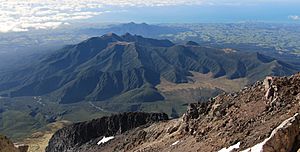Kaitake Range facts for kids
Quick facts for kids Kaitake Range |
|
|---|---|

The Pouakai Range as seen from Mount Taranaki, with the Kaitake Range in the background.
|
|
| Highest point | |
| Peak | Patuha |
| Elevation | 675 m (2,215 ft) |
| Geography | |
| Location | North Island, New Zealand |
The Kaitake Range is a mountain range in the North Island of New Zealand and the northwesternmost stratovolcano in the Taranaki region. Like the neighboring Pouakai Range, Kaitake is eroded and heavily vegetated, having formed during the Pleistocene epoch.
Kaitake is roughly 500'000 years old and had collasped about 200'000 thousand years later due to the collapse of Pouakai Volcano. Kaitake and Pouakai would continue to be damaged from the erupting Mount Taranaki volcano.
The region would often be reshaped after each cone collapse from Mount Taranaki.
Other Volcanoes In The Area
Sugar Loaf Islands - Dated -1.7 Million Years
Pouakai Volcano - Dated -500 - -250 Thousand Years
Taranaki Volcano - Dated -127 Thousand Years
Activity
"At the beginning of Hāwera time a fresh active centre arose at Kaitake. It shows no obvious structural relationship with the Sugar Loaves and appears to have been the first activity on a new line. Volcanism from this centre continued during three episodes of ring-plain formation alternating with two episodes of marine cliffing, before it became extinct. The agglomerates of the younger two ring plains have been seen to overlie marine sediments deposited during the previous Kaiatea II and III periods of marine cliffing. The volcano produced is now so greatly eroded that the detailed form of the peak is unknown. However, the shape of the lower parts of the volcano, still well preserved, suggests that it was essentially a simple cone on the Egmont plan rather than a complex feature like the volcanoes of Tongariro National Park. After the extinction of the Kaitake centre, eruptions broke out at Pouakai 6 miles south-east of Kaitake. Activity from this centre continued over a long period of ring-plain formation, a period of marine erosion during which volcanic activity decreased, and part way through another period of ring-plain building, before activity broke out from the next centre."

